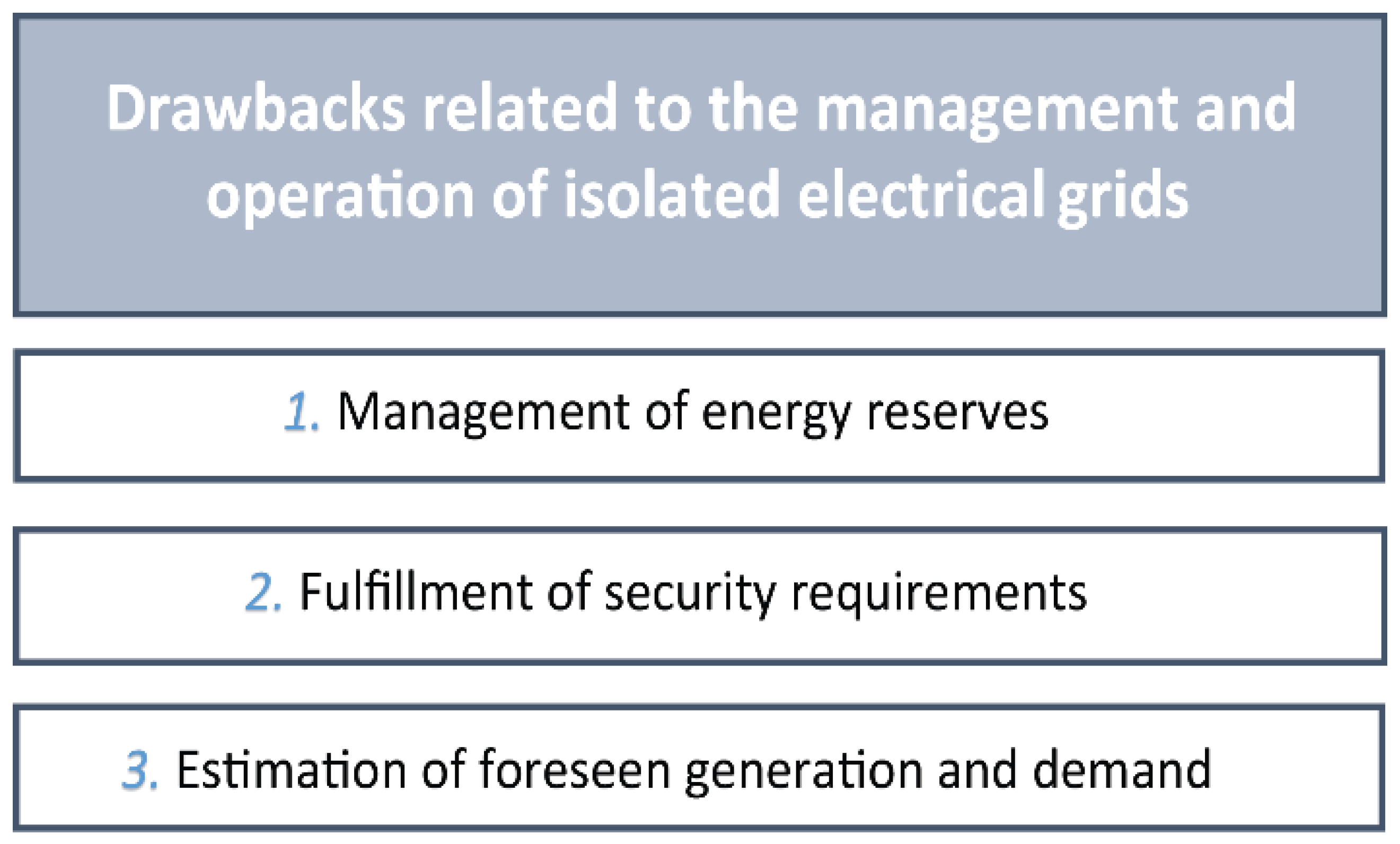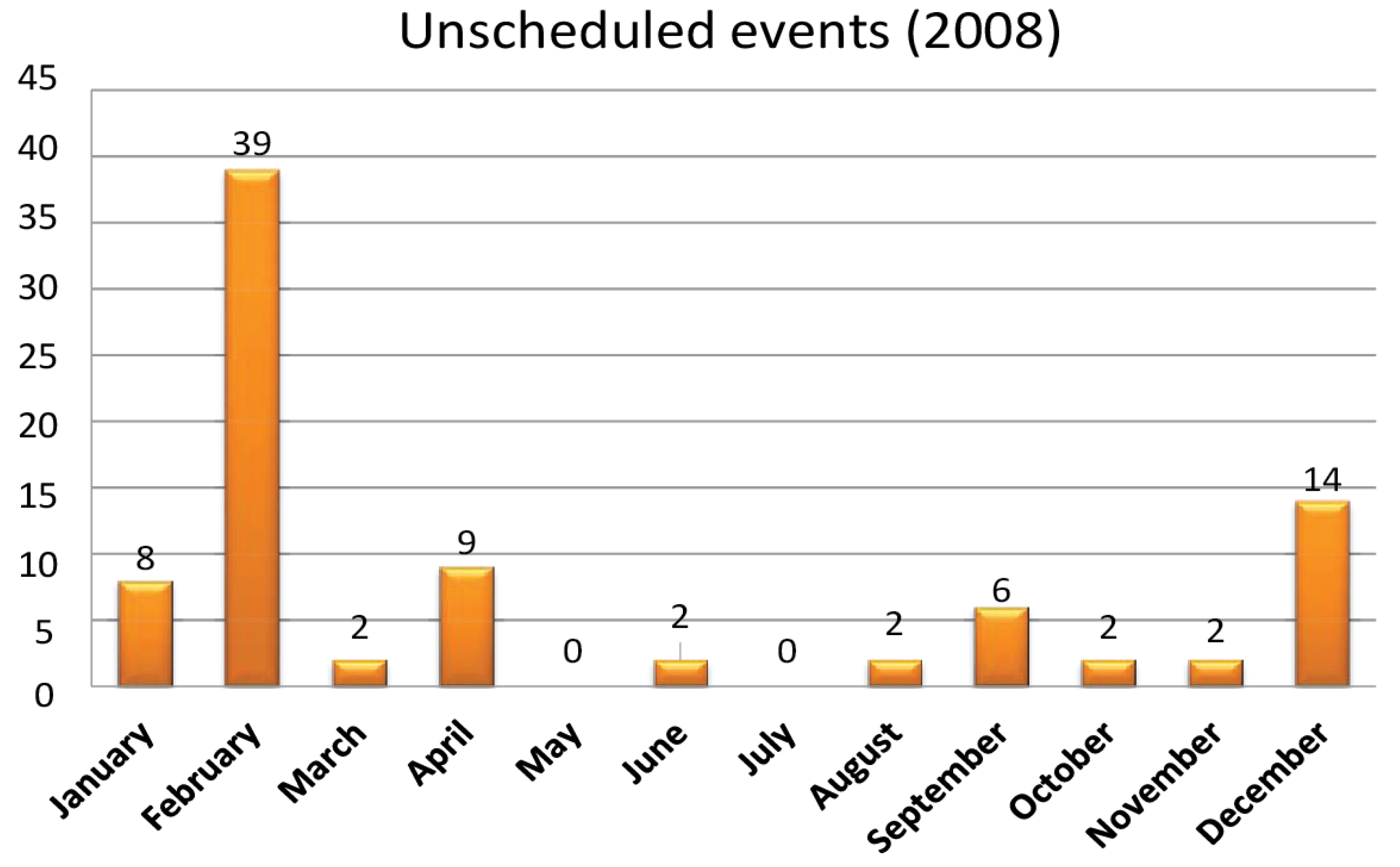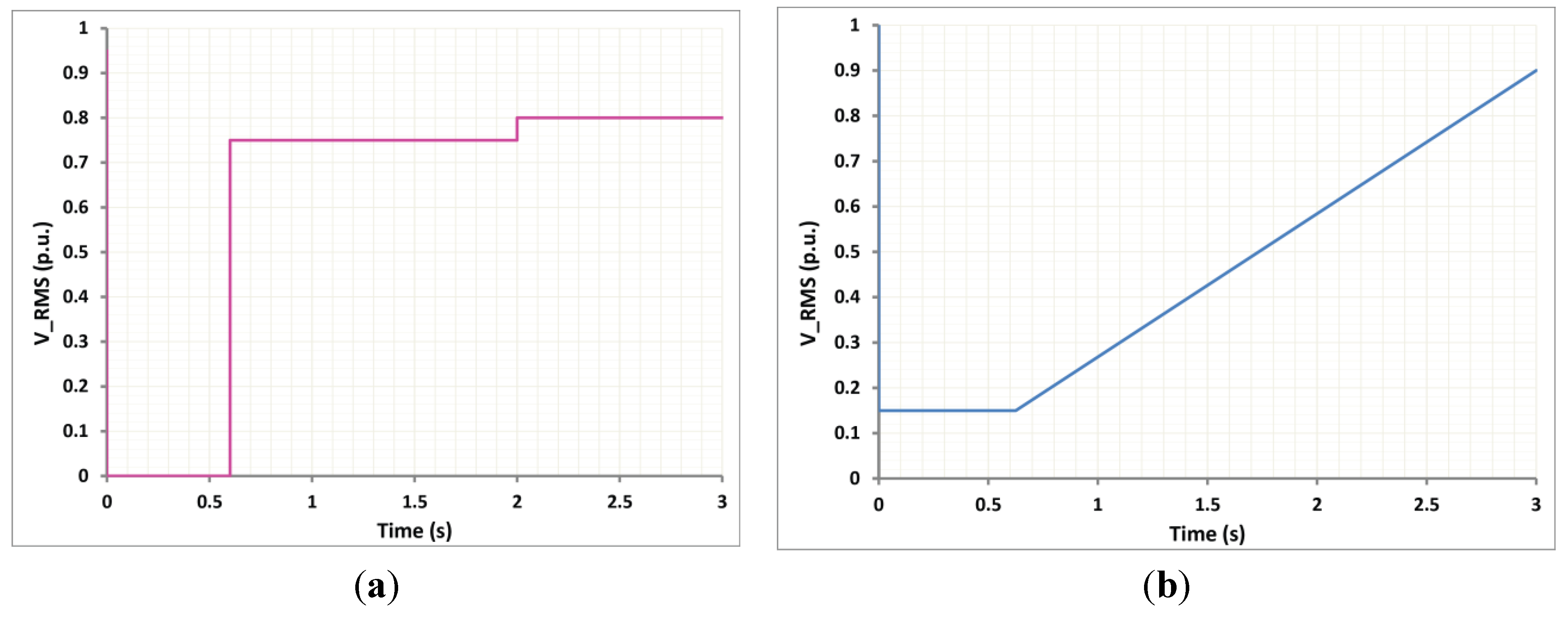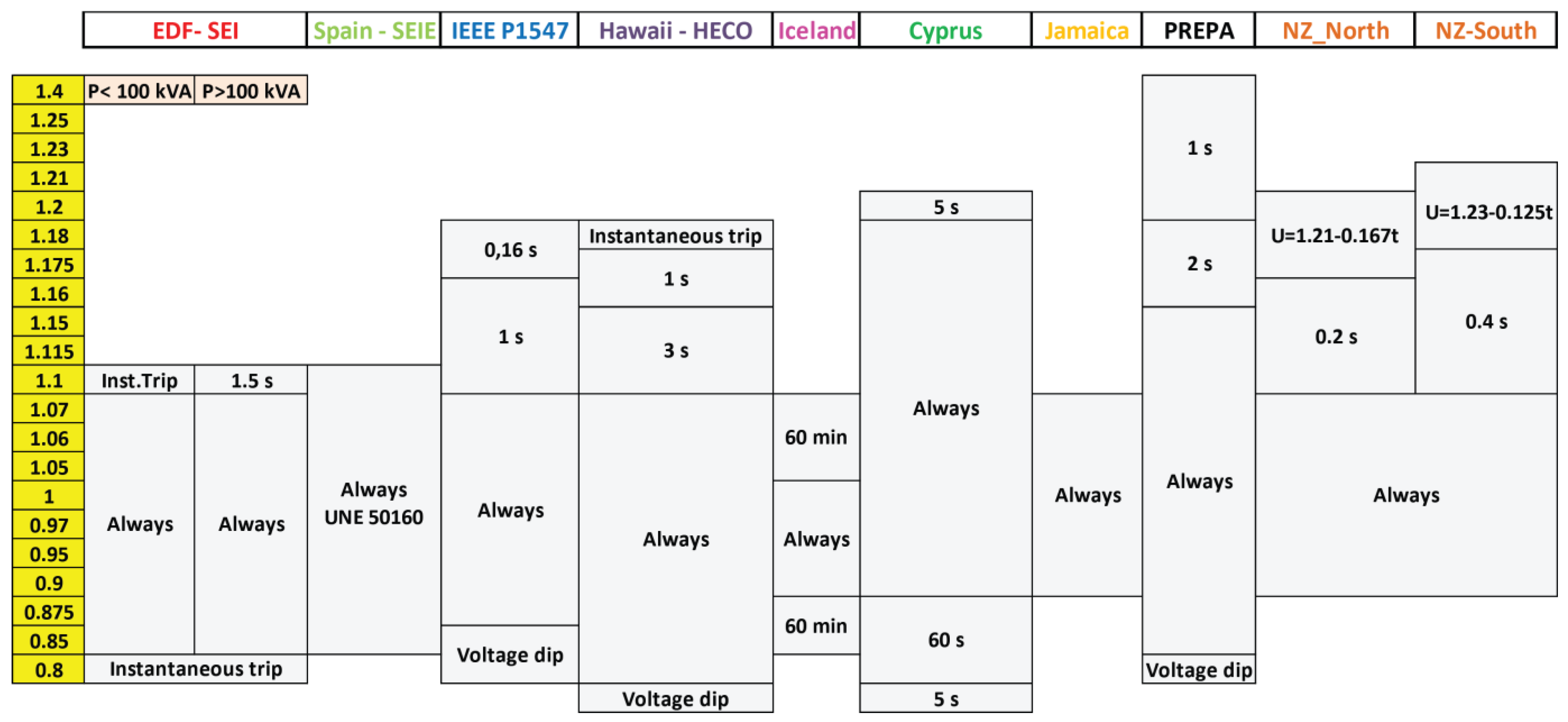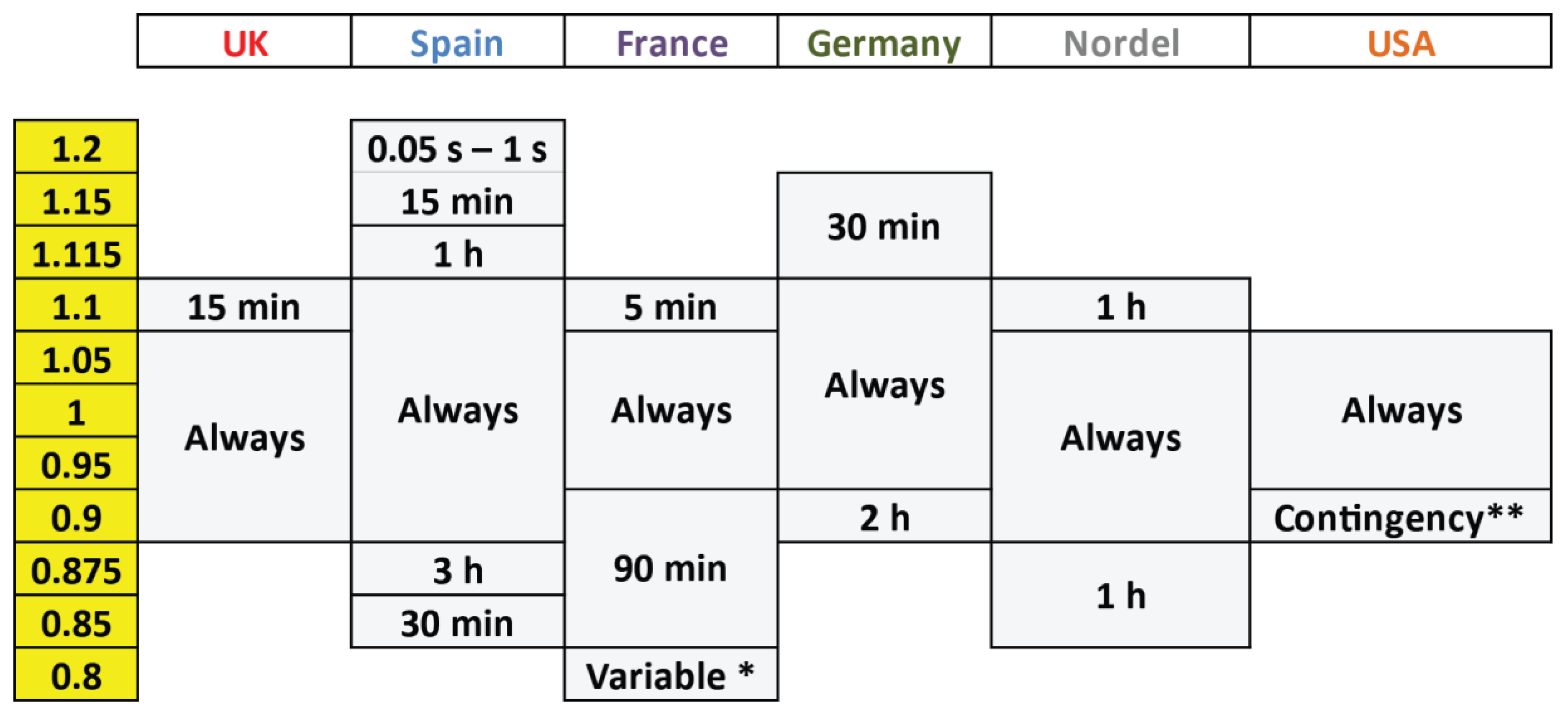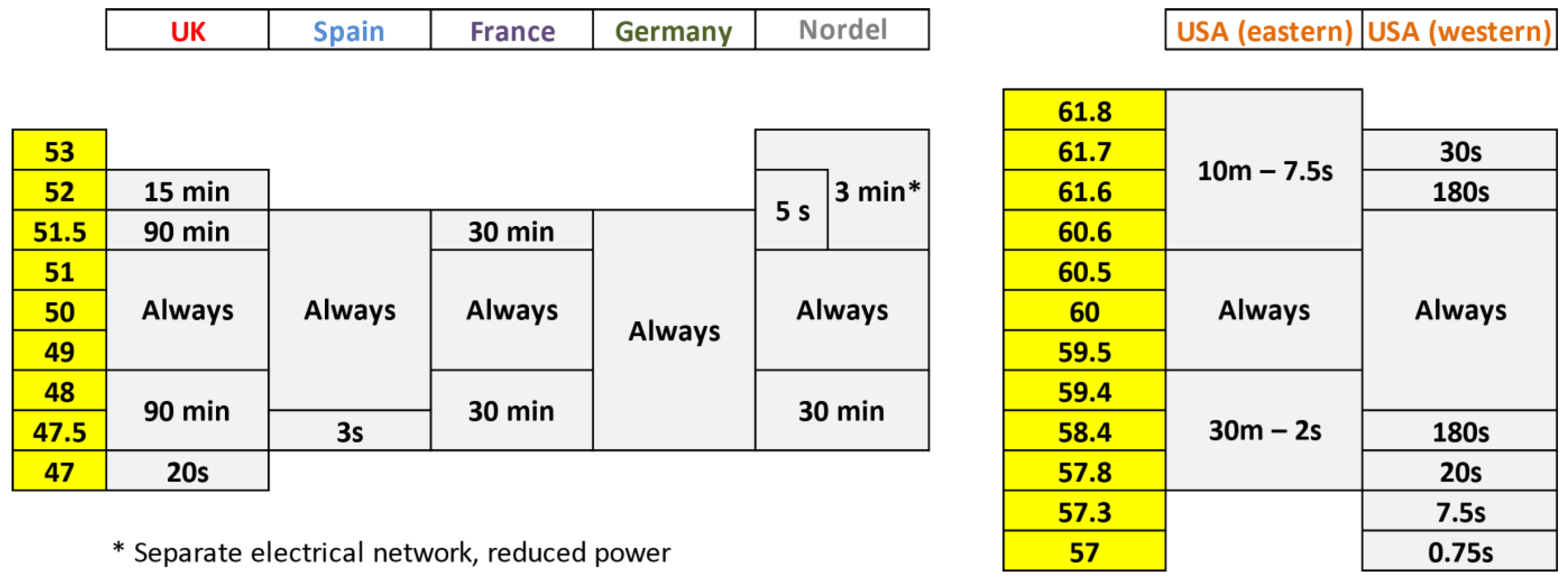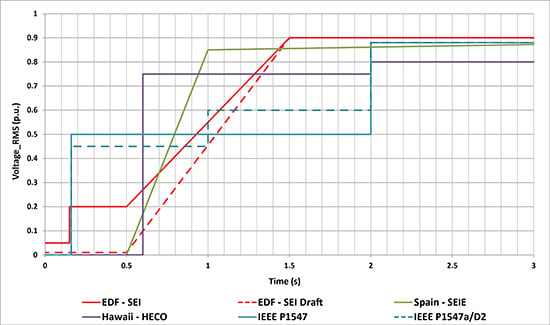1. Introduction
According to the European Directive 2009/72/EC, a small isolated system is defined as a system that consumed less than 3000 GWh in 1996 and which received less than 5% of this energy through interconnections [
1].
Isolated systems are usually found in remote or geographically isolated locations, mainly on islands or settlements in developing countries, in areas of high ecological interest which must be protected and where there is abundance of renewable energy resources. Typically, they have a centralized topology, with radial networks and a few generation nodes that concentrate all the electrical power supply.
At present, isolated electric systems largely depend on fossil fuels [
2]. Until recently, only diesel generator groups were able to ensure a secure and reliable supply in exchange for very high prices in the transport of fuel and in the operation of the system. New energy models pursue two main objectives: replacing conventional generation with renewable sources and improving overall system efficiency.
Because isolated power systems are not connected to the utility grid, they must be designed independently to fulfill additional requirements of reliability, efficiency and power quality. Moreover, because a high percentage of supply depends on renewable energy, which is usually not controllable, it is necessary to establish new management protocols to ensure the safety and reliability of the electrical system at all times. It follows that the technical requirements of the grid codes in isolated power systems are generally stricter than those for interconnected systems.
There are three aspects that make clear the need to develop specific grid codes in isolated grids. These are highlighted below, and also shown in
Figure 1.
Figure 1.
Main drawbacks associated with isolated grids.
Figure 1.
Main drawbacks associated with isolated grids.
1.1. Management of Energy Reserves
Management of isolated power systems is strongly influenced by the impact that contingencies have on the system operation. This impact is stronger in isolated systems than in interconnected ones, thereby necessitating greater levels of energy reserves as well. For this reason, conventional units work below their rated power, and thus lead to cost overruns. In fact, this value is usually the minimum reserve allowed by the regulatory framework of a given country and, in many cases, is insufficient. Therefore, it is common in these systems, before a severe failure, for the system operator to restore the normal operation of the isolated grid through interruptible load shedding.
1.2. Fulfillment of Security Requirements
In isolated grids it is difficult to foresee any incidents that may arise because they have a high degree of operation uncertainty, which is dependent on the variability of the voltage levels on the grid. In isolated grids, fluctuations in node voltages (due to voltage drops in the lines’ impedances) are larger when compared to interconnected systems. Networks that have not yet implemented distributed generation (DG) have a risk inherent to the fact that the power plants are concentrated in a few nodes. The topology of the isolated grids are also slightly meshed networks with low voltage levels (<66 kV). For the aforementioned reasons, it is common in these grids to have a high number of violations of N-1 security criterion under fault/incident conditions. As an example,
Figure 2 presents data of unscheduled events recorded during 2008 in the Canary island of La Palma (Spain) [
3]. The variability in the number of failures is very high. This fact makes the grid management difficult.
Figure 2.
Number of unscheduled events recorded per month in La Palma (2008).
Figure 2.
Number of unscheduled events recorded per month in La Palma (2008).
1.3. Estimation of Future Generation and Demand
The difficulties in medium- to long-term energy forecasting, in the presence of non-dispatchable generation or demand, include problems in estimating the ratio between conventional and renewable generation needed in the system to ensure stability.
2. Characterization of Voltage and Frequency Disturbances in Isolated Power Systems
2.1. Voltage Dip
The contingency that mostly affects the power quality in the electrical system is the voltage sag. This is to such an extent that it represents almost 80% of short-term disturbances that occur in the grid [
4]. A voltage dip is, as defined in [
5], a sharp decrease in the voltage at an interconnection point followed by subsequent restoration and whose duration is comprised of periods lasting from 10 ms to 1 min.
The causes of a voltage dip are related to the connection or disconnection of elements in the system, either for operational reasons or because of short circuits. In isolated power systems, nodes are usually physically close together, connected through very short distribution lines and are electrically equivalent points. The relative power of the generators/loads with respect to the total power of the system is also important. These circumstances determine the characteristics of the voltage dips which are usually present in isolated power systems: they are very deep and their area of propagation is very wide-spread.
Figure 3.
(a) Characteristic voltage dip in El Hierro Island; (b) spread of a voltage dip in Gran Canaria Island.
Figure 3.
(a) Characteristic voltage dip in El Hierro Island; (b) spread of a voltage dip in Gran Canaria Island.
Figure 3a shows the time-domain profile of a typical voltage dip in the 20 kV distribution network of the isolated system of the island of El Hierro [
6]. This system, located in the Canary Islands, has an installed capacity of 11.5 MW [
7]. It is noted that the voltage at various close nodes of the network is practically the same, as expected for this small grid.
Figure 3b shows how the voltage dip is seen in the electrical system of another Canary island, in this case, Gran Canaria, a much larger system (1120 MW) [
6]. A short circuit at the output of the 66 kV power station affects the entire network and no node is capable of staying within the permissible voltage limits of the system.
2.2. Voltage Swell/Overvoltage/Undervoltage
In isolated electrical systems, voltage drops in any line or node cause significant voltage fluctuations in all elements of the system. In this type of grid, lines have large impedances that cause voltage drops subject to changes in the load of the line. This phenomenon seriously affects the power quality in the network.
2.3. Frequency Oscillations
In any electrical system, frequency oscillations appear as a consequence of the imbalances between generation and load. The equation of motion of an electrical machine’s rotor expressed in per unit (p.u.) is shown:
where
Pm and
Pe are the total generation and load power, respectively, in p.u.,
H is the sum of the inertias of the synchronous generating groups, in seconds, and
ω is the speed of the machines, in p.u. From Equation (1) it follows that the rate of change in the rotational speed of the generators, and therefore the frequency of the network, is directly proportional to the instantaneous imbalance of generation and demand and inversely proportional to the sum of the inertias provided by the generating groups. In isolated grids, low-inertia diesel gensets can usually be found, which in the event of disturbance leads to frequency excursions greater than those that would occur in an interconnected system.
3. Current Status of Isolated Power Systems
Many of the systems that were remote and isolated have been progressively connected to other networks with similar characteristics, or to the mainland, due to the development of underwater interconnections using HVDC/HVAC links. Some examples of isolated networks that are connected to others but remain in the isolated category—with their associated problems—can be found in some of the Hawaiian Islands; North and South New Zealand; and in the Canary Islands (Lanzarote and Fuerteventura Islands). Other cases will appear in the future, such as the interconnection that is projected between the islands of Guadeloupe, Martinique and Dominica [
8]. Sometimes, the connection to an island provides a connection to the mainland through such island, as is now being developed for the connection of the Italian Islands (Insula Project) to continental Italy [
9] or has been carried out to link Sri Lanka to India [
10]. Concerning the connection of remote grids to continental territories, two projects should be mentioned for the technological challenge that they represent. The first of these is the EuroAsia Interconnector Project, which is developing a link of almost 1000 km in length and a capacity of 2000 MW, which will join the grids in Cyprus and Crete to the continental network of Greece and Israel, and whose commissioning is scheduled for 2016 [
11]. The second project, not yet started, will allow a connection between Iceland and the United Kingdom [
12]. Iceland has a very important geothermal, hydraulic and wind potential, so it is able to generate nearly five times the energy it consumes at a very low price. Importing cheap energy from Iceland to the United Kingdom will create an economic advantage for both countries and therefore the United Kingdom will not have to expand its offshore wind generation capacity.
For other outlying electrical systems it is not possible to plan interconnections due to the high cost that presupposes the construction of the linkage (not acceptable, for example, for remote grids in developing countries) or due to the geographical situation. This happens in the Canary Islands: the distance between the islands and the mainland, and especially the depth of the ocean floor, make the connection unviable. As for future (although unlikely) solution, HVAC links may be used to establish possible inter-island connections through offshore wind farms [
13]. It is in these isolated electrical systems, without the possibility of later connection to the utility grid, that the need to develop new specific codes takes on special importance. This will be fundamental to carrying out changes of energy model supply towards the integration of clean energies.
4. Overview of Grid Codes
The increasing integration of non-conventional sources in power systems—mainly wind power—has forced the transmission and distribution system operators (TSOs and DSOs) to update and redesign their grid codes. The grid codes are essentially sets of connection and behavior rules that generators in power systems must satisfy. The rules are different in each country and the corresponding operator is responsible for establishing those conditions and enforcing compliance. The grid codes take the electrical characteristics and the network design as reference, and their requirements are directly linked to the non-dispatchable power present and expected penetration rate.
Figure 4.
Relationship between grid codes and renewable energy development.
Figure 4.
Relationship between grid codes and renewable energy development.
With the new policy, the following goal is pursued: to equate the behavior of renewable generation to the conventional groups already in service. This ensures that the replacement of a generation units in the system by others means no additional risks in reliability. There is a close relationship between regulations, the consequences that these establish for manufacturers, and non-dispatchable energy penetration rate in the system. The graphical summary of this idea can be seen in
Figure 4.
Increasing demands on the grid codes require manufacturers to make improvements on their devices, resulting in the evolution of the technology of generation systems and control drives. An effective contribution to grid anomalies is reached by the improved distributed generating sources and the inclusion of non-conventional generation is favored. The boost of the renewable energy penetration rate forces new modifications of grid codes.
In each country, the regulatory framework is complex and changing, forcing manufacturers to adapt their products according to the market for which they are oriented. The requirements of the grid codes can be differentiated according to the type of technology they are applied to, the installation characteristics, or the voltage level of generation. In some cases, the corresponding grid code is equally applicable to all power generation sources, as it happens in India [
14]. In others, only the required response of wind installations is defined in a code, as in the P.O.12.3 in Spain [
5], in China [
15] or in the new draft procedure in India [
16]. The German code [
17] distinguishes between synchronous generators and those technologies that do not employ a synchronous generator directly connected to the grid. It will be done in the same way in the Spanish code to be approved, P.O.12.2 [
18]. The code P.O.12.2 includes other sources of generation such as photovoltaic, whether they are connected to the transport grid, or to distribution grids and are greater than 10 MW. In other relevant codes such as the Danish grid code, the requirements are different not only in terms of the technology used but also depending on the voltage level and the power of the generating plant [
19,
20,
21].
Despite these differences, all regulations are structured in a similar way. These regulations gather (a) the rules for connection requirements, (b) all the aspects related to the operation and safety criteria (known by the generic name of Operating Procedures), and (c) the rules related to the electricity market [
22]. For the purposes of this work (the comparison between different network codes), isolated systems will be linked to issues addressed in the connection requirements and/or Operating Procedures, such as voltage and frequency disturbances.
5. Requirements in Grid Codes
This section addresses the general aspects related to the requirements in grid codes. For the purposes of this work, the obligations of active and reactive power contribution and, in general, all the conditions that depend on the generator control systems have been left out of the analysis.
5.1. Voltage Disturbance Requirements
For the proper operation of the electrical systems with distributed generation, system operators (SOs) must keep the voltage within acceptable limits under normal operating conditions in all grid nodes. Moreover, generation groups are responsible for helping SOs to meet those requirements, staying connected during unusual circumstances in the system and restoring its previous operating condition as quickly as possible after clearance of the fault.
Regulations for low voltage ride-through (LVRT) in any grid code are collected in the form of profiles, which report the permissible voltage levels and associated duration times.
Figure 5.
Voltage dip profiles types: (a) rectangular; (b) with recovery ramp.
Figure 5.
Voltage dip profiles types: (a) rectangular; (b) with recovery ramp.
Two types of existing profiles in grid codes can be observed (as shown in
Figure 5): (a)
Rectangular profiles: based on steps of protection tripping. (b)
Profiles with recovery ramp: represent the most severe profiles obtained by statistical analysis of network failures. The performance criteria for other disturbances are always determined by protection tripping times. This is the case of overvoltages, undervoltages or voltage swells.
5.2. Frequency Disturbance Requirements
The frequency of the system is an indicator of the stability degree, since any instantaneous imbalance between generation and demand results in a variation of the magnitude of the frequency. Thus, it is directly related to the active power requirements of the generation control systems (governors). The amplitude and period of the frequency oscillations depend on the characteristics of the loads connected and the transient response of the generating units’ regulators. Both conventional and renewable generation sources must be able to stay connected and in operation if the electrical system is subject to fluctuations in a permanent or transient regime. Likewise, in some regulations, additional obligations require sources to support continuous deviations of frequency over a period of time (Rate of Change of Frequency–ROCOF) that can appear as a result of very abrupt changes in power-demand balance.
5.3. Phase Shift Requirements
A phase shift naturally happens in an electrical power system after a grid fault, as a result of a change in the impedance of the equivalent circuit. A phase shift is a displacement that occurs in a voltage wave with respect to a reference that has the same frequency and harmonic content. This reference usually is the voltage at the point of common coupling (PCC), prior to disturbance. The phase shift requirements are very specific and are only included in the most advanced grid codes.
6. Grid Codes in Isolated Systems
Current regulations on grid codes applied to isolated power systems are scattered and incomplete. This is due either to: (a) lack of specific regulations in small-sized electrical systems (and sometimes systems in developing countries) or (b) the small number of installed renewable generation sources which do not justify the creation of a law regulating its integration into the electrical system. In the technical literature review, examples of regulations have been found for large isolated electrical systems (>50 MW). Three of the most significant regulation framework examples that have been specifically developed for medium or small electrical systems (<50 MW) will be described below.
The first example is located in Spain, where the smallest island of the Canary Islands, El Hierro, has an installed capacity of only 11.5 MW. The Canary Islands are currently electrical systems pioneers in terms of bulk inclusion of renewable energy. Spanish law is forced to take into account the Canarian system’s special conditions. Therefore, the operating procedures established by the Spanish system operator (REE), includes a specific voltage dip profile for the Canary Islands, which is different from the peninsular territory or other Spanish isolated power systems such as Baleares, Ceuta or Melilla [
23].
The second example corresponds to France, which has several islands—St Pierre et Miquelon, Guadeloupe, Martinique, Reunion and Corsica—with installed capacity between 27 MW and 435 MW [
24]. The IEEE Std. 1547 constitutes the third example. The IEEE Std. 1547 applies to up to 10 MW distributed generation sources connected to microgrids. In the strict sense, a lone source of that size and associated controls and protections would form a microgrid. If this microgrid worked in isolated mode without the possibility of subsequent connection to a larger grid (which is known as remote microgrid), it would also be an isolated electrical system itself.
In isolated power systems the preservation of a high proportion of backup conventional generation is essential for safety. Therefore, French law establishes that the system operator can command disconnection of renewable generation sources when they reach an instantaneous penetration level of 30% or more [
25]. In the Spanish code there is no imposed limitation in this respect and the disconnection depends on the particular legislation established for each island. By the year 2015 it is expected that in the Canary Islands the renewable energy penetration in both peak and off-peak periods will fully cover the demand [
7]. This will necessitate the search for efficient energy storage solutions or important spills of wind energy. The management of a system completely fed by renewable energy sources and the control over the surplus energy poses the challenge of no well-known previous experience.
6.1. Voltage Dip
Figure 6 shows the most representative profiles of voltage dip for isolated power systems.
Figure 6a collects profiles applicable to electrical systems of less than 50 MW and
Figure 6b to those that are over 50 MW.
A quick analysis shows that voltage dip profiles are usually more demanding when the size of the grid is smaller. Virtually almost all profiles defined for isolated power systems include the requirement to withstand a voltage dip to zero. This is due to the characteristics of the systems outlined in the introduction. It is worth noting that the voltage dip profiles are established by a combination of factors such as the registry of historical events, the radial or meshed grid topology or the renewable energy penetration ratio—current and expected.
Figure 6.
(a) Voltage dip profiles for systems up to 50 MW; (b) Voltage dip profiles for systems greater than 50 MW.
Figure 6.
(a) Voltage dip profiles for systems up to 50 MW; (b) Voltage dip profiles for systems greater than 50 MW.
This requirement is known as zero voltage ride through (ZVRT). In contrast, interconnected electrical systems are enforcing ZVRT in those systems that have a higher proportion of installed wind power, such as US (NERC), Germany or Spain in its to-be-approved operation procedure [
18]. In the current EDF-SEI code, the required voltage dip depth is 0.05 p.u. [
26]. To allow the increase of renewable energy penetration in the French islands, a modification of this profile is proposed for a future policy, with a required voltage dip depth of 0.01 p.u. [
27]. The forthcoming adoption of a new profile is also expected in an amendment to the regulations currently in service in IEEE P1547 (IEEE P1547a/D2). In the P.O.12.2-SEIE, applied to the Spanish Canary Islands, a pattern of 0 p.u. during 500 ms is required. For the rest of island territories, the profiles required are the same as in the mainland.
6.2. Overvoltage/Undervoltage
The over/under voltage operation ranges tolerated in isolated systems, presented in
Figure 7, are stricter than the ones observed in interconnected systems. The widest operating boundaries for interconnected systems will be required in the new draft procedure of Spain, Draft P.O.12.2, in which the generator should remain connected for 30 min with a voltage as low as 0.85 p.u. and 50 ms if the voltage is 1.20 p.u. As a comparison example, the case of an undervoltage event of 0.85 p.u occurs in the EDF-SEI, Spain SEIE, HAWAII-HECO and Puerto Rico-PREPA isolated grid codes [
28]. Under these grid codes, generators should not disconnect. In other regulations, 0.85 p.u. is considered a voltage dip instead.
Figure 7.
Overvoltage/Undervoltage requirements comparison for main isolated grid codes.
Figure 7.
Overvoltage/Undervoltage requirements comparison for main isolated grid codes.
6.3. Frequency Oscillations
Figure 8 shows the grid operation requirements for fluctuating frequency conditions in different grid codes for isolated systems. It is observed that, in some cases, the frequency fluctuations that systems must continuously withstand are very important. Note, for example, the case of the South Island of New Zealand, where the steady state frequency can fluctuate up to 8 Hz. These levels would be completely unacceptable to any interconnected system.
Figure 8.
Frequency requirements in main isolated grid codes.
Figure 8.
Frequency requirements in main isolated grid codes.
6.4. Derivatives of Frequency
The requirement that generation sources remain connected under deviations of frequency is not common to all analyzed network codes, but is reflected in some of them. For example, generators must remain connected to variations of up to 0.37 Hz/sin Hawaii, 0.75 Hz/s in New Zealand, and up to 1.3 Hz/s in Cyprus.
7. Comparison to Grid Codes in Interconnected Systems
7.1. Voltage Dip
Figure 9 shows the fault ride through profiles for the grids in the UK [
29], USA [
30], Germany [
17], France [
31], Spain [
18] and Nordic countries [
32], all at the transmission level. Even though the LVRT requirements vary from country to country, they all require ZVRT for the first hundred milliseconds. The profiles are, nonetheless, similar to the ones of isolated systems.
These requirements are, however, not as strict at distribution level.
Figure 10 shows the voltage dip profiles at such level, where only a selected number of countries differentiate between transmission and distribution level. In the particular case of the UK, the grid code does not refer literally to distribution level, but instead to off-shore installations on the low voltage side [
29]. Also, the profile of Spain is particular to wind power [
5]. Nevertheless, in these cases the profiles are not as demanding due to the assumption that the faults may occur upstream and that voltage support at lower voltage level would still be provided.
Even though an isolated system might be topologically more similar to a distribution system, the voltage dip requirements in isolated systems are as strong as in transmission systems. Moreover, the duration of ZVRT is longer in isolated systems (e.g., 500 ms in Spain, as per P.O.12.2-SEIE), compared to a typical 140–150 ms in several interconnected grid codes.
Figure 9.
Voltage dip profiles for interconnected systems (transmission level).
Figure 9.
Voltage dip profiles for interconnected systems (transmission level).
Figure 10.
Voltage dip profiles for interconnected systems (distribution level).
Figure 10.
Voltage dip profiles for interconnected systems (distribution level).
There are not many countries where the existence of different grid codes for mainland territory and islands allow the evaluation of the differences between the voltage patterns in both codes. France and Spain are the only countries where this comparison can be made. In France, a zero voltage dip profile is required for 150 ms in transmission and 250 ms in distribution but is not a condition for the islands. However, for longer voltage dips, the code is stricter in the isolated territories (350 ms at 0.2 p.u. instead of 0.5 p.u.). In Spain it is clear that the profile for islands is more demanding compared to the mainland territory. This is chiefly due to the special case of the Canary Islands. The weaknesses of its electrical grids along with to the local government strategic plans to promote a notorious insertion of renewable energy sources forced the tightening of voltage ride-though requirements.
7.2. Overvoltage/Undervoltage
Figure 11 presents over- and under-voltage requirements for the same countries mentioned above, as covered in the same grid codes. Even though they vary from country to country, it is often found that there is a 10%–15% voltage band in which the systems operate all the time.
Figure 11.
Overvoltage/Undervoltage requirements for interconnected systems.
Figure 11.
Overvoltage/Undervoltage requirements for interconnected systems.
In contrast to isolated systems, the bands are much narrower in the interconnected case. Requirements shown in
Figure 7 for example present a voltage band from 20% to 30%. However, it is important to note that, even though the band is narrower in interconnected cases, the allowed times outside the bands are much longer than in the isolated case. In other words, isolated grid codes allow wider variations but shorter trip times compared to interconnected grid codes.
7.3. Frequency Oscillations
Figure 12 shows the frequency requirements for the same countries mentioned above. Once again, the bands in the interconnected case are stricter than in the isolated case. In contrast to the bands of 2 Hz–3 Hz in isolated systems, interconnected systems only allow 1 Hz or 2 Hz deviation. Similar to the overvoltage and undervoltage case, the tripping times are much longer in interconnected cases.
7.4. Phase Shift Requirements
The most advanced grid code in this respect is the Danish code [
21]. This is the only one that requires the installation to be capable of staying connected when subjected to an instantaneous 20° phase shift. The new Spanish code P.O. 12.2, which targets distributed generation facilities, will be even stricter, establishing a criterion of phase shift of up to 30°. Note also that in this code, the requirement for the DG is more severe than for conventional generators, which are forced to remain connected under jumps of phase of 20° and only occasional jumps of 30°, as a result of closures of transmission lines switches.
Figure 12.
Frequency requirements for interconnected systems.
Figure 12.
Frequency requirements for interconnected systems.
8. Future Trends in Isolated Grid Codes
Depending on the regulatory framework of different countries, manufacturers may be required to certify their equipment according to each of the grid codes of territories where they commercialize their products. Thus, the creation of a common grid code would allow increasing levels of security and stability in the network and facilitate the inclusion of new sources of renewable generation in the system. That is why the need to harmonize the different regulations is clear. Europe has made great strides in this regard, by means of the ENTSO-E organization. This organization brings together the technical operators of the European electrical systems and is responsible for both coordination between different TSOs and controls energy exchanges across European borders, in collaboration with the Agency for the Cooperation of the Energy Regulators (ACER) and the operators of the electricity market. The ENTSO-E organization has many years of experience in the development of joint legislation, ensuring minimum requirements that must be specified in all the member states, unified terminology, and a set of compliance obligations and exceptions equally applied to all European countries. From the perspective of the definition of an isolated system, there are various European territories that meet the characteristics presented in the introduction, such as the Canary Islands, Cyprus, Malta, Madeira or the Åland Islands. The ENTSO-E code aims for the unification of the grid codes for the construction of a pan-European electrical system. The isolated power systems would presuppose a very small impact on the global system (if they could finally be connected to the interconnected system or no impact if kept isolated by geographical circumstances). In either case, the effects of electrical systems will be minimal and are excluded in this initial version of the European code ENTSO-E.
However, the importance of finding agreement on the unification of the existing laws in the different territories has forced the creation of a group within the structure of ENTSO-E, specializing in isolated systems: the Regional Voluntary Group Isolated Systems (VRG IS). Four operators are members of this group: REE (Spain), Terna (Italy), Landsnet (Iceland) and Cyprus Transmission System Operator (Cyprus). Its mission will be to ensure the proper management and operation of the isolated power systems and provide expertise so that the development and updating of the grid codes will take into account the particularities of isolated power systems. The experience provided by the VRG IS is expected to be included in future publications of the code [
33].
The increasing integration of non-conventional energy sources in traditional networks suggests that the general idea that the legislation pursues is to ensure that these sources react to disturbances like conventional generators do. The regulation ensures that the replacement of some sources of generation by others does not pose additional risks for the electrical systems. Although this is necessary in every network, it will be more relevant to weak grids. For this reason, the inclusion of several additional requirements is expected over those codes currently in service. The first version of the Spanish grid code P.O.12.2, published in 2008, cited some requirements and even the specific mode of implementation in the system. Spanish regulation is one of the most advanced and since Spanish operator REE is a member of the ENTSO-E, it is likely that the guidelines stated on this draft code will be extended to future grid codes. These new requirements for non-conventional generation would be twofold:
- -
Emulation of inertia: It will be required that non-conventional generation sources, connected through a converter, emulate the inertia provided by the spinning mass of conventional generators. Non-conventional sources should be able to increase or decrease the active power that they inject at the point of common connection according to frequency deviations.
- -
Capacity of damping frequency oscillations in the system: The generating system must be capable of providing active power that can compensate for the low-frequency oscillations in the system. Some fast energy storage systems would provide primary reserve and collaborate in short-term frequency-control balancing task. For example, high speed flywheels (10,000 rpm) coupled to bidirectional drive motor-generator, can achieve very pronounced ramps response (2 s from null to full load), and can be suitable to integrate in Wind Power plants [
34].
Besides these two requirements, the first version of the 2008 Spanish Code expresses the desirability of control systems to evolve to provide negative sequence during power disturbances.
9. Conclusions
There are difficulties in integrating intermittent energy resources in any electrical system. These difficulties are aggravated in an isolated system. On the one hand, the replacement of conventional generation sources by renewable sources is especially desirable in isolated systems, given that such systems currently have a high external energy dependency which increases the costs of electricity supply. On the other hand, the inability of the isolated systems to connect to the utility grid, which usually is a rigid grid, increases the stability and security problems in the network. As a result, there is a growing the number of TSO that include, in their operation codes, specific requirements to facilitate the inclusion of non-conventional energy—especially wind energy—in isolated power systems. In those codes, the requirements established by the operators are more demanding. There are many isolated systems that, given its very small size or location in developing countries, lack specific codes. Moreover, the legislation associated with the development and approval of new grid codes is constantly changing. This work compiles the current status of isolated power systems, showing the need of develop specific grid codes for them and collecting several examples of existing grid codes applied to weak grids.
